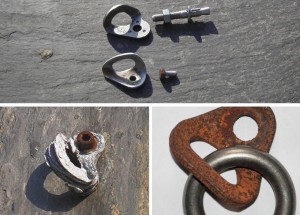Back up in situ metal protection like spikes, pegs and bolts where possible with other protection. Metal spikes and pegs will be most corroded below the surface and whilst you can test to see if it’s wobbly there is little more you can do to check how sound it may be. Rust may appear superficial but hidden below it may have taken hold. Tying off the spike or peg as low as possible will minimise the leverage on it.

Bolts are a little different as there may be notes on their history in a guidebook. Knowing when the bolt was placed and what type it is will help your judgement. Stainless Steel is less likely to corrode than plain steel. Resin bolts have a longer lifespan than simple expansion bolts. Some of the bolts on crags are little more than 8mm thick and 30mm long and may have been in place for over thirty years. If the bolts are subject to the salty conditions of a maritime environment, treat them with further caution.
Using different metals for the bolt, nut and hanger can cause an electrolytic reaction which will rapidly corrode one part or other. If the bolt has signs of rust and the hanger doesn’t its an indication of mixed metals reacting with each other. Some aluminium hangers react with the bolt, resulting in oxidisation.

Abandoned Equipment
One way to lookout all fixed metal equipment in a cliff is that is is essentially abandon equipment with a dubious history of use and abuse. Whilst in many sports climbing areas there are voluntary groups that check the bolts and re-equip the routes from time to time. This is not always the case.
Even if some bolts are not that old, there are other issues, some bolts have failed as they have been overused and in soft rock. This has lead to bolts pulling out almost by hand after only 5 years of heavy use.
So look at bolts carefully, do they look OK? Do they feel OK? Do they move?

